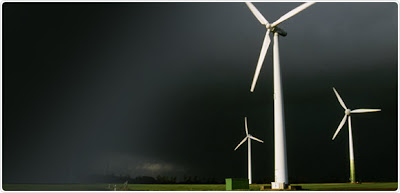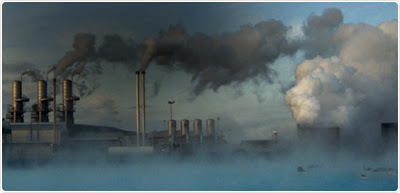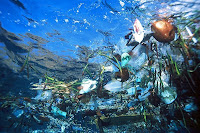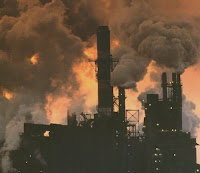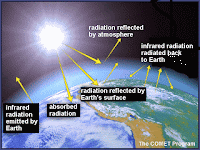A broad scientific census says that Earth is already experiencing significant global warming. So how hot will it get, how soon, and to what effect? Some climate scientists warn that the pace of global warming could be much more rapid than that predicted even a few years ago.
"Any time you get into projections, you get into a lot of uncertainties. But the [climate] models are getting a lot stronger," said Jay Gulledge, a senior research at the Pew Center on Global Climate Change in Arlington, Virginia.
Gulledge says some current projections point to a rise in average global temperature of 0.5°C (slightly less than 1°F) by the year 2030.
The estimates are based on greenhouse gasses already in the atmosphere. While the temperature increase is small, it would be significant. Over the past century Earth has warmed about 1°F (0.6°C). (See our fast facts on global warming.)
Gulledge cautions, however, that warming rates depend on many factors, some of which have yet to be discovered.
"One of the big unknowns is how society will react," said Antonio Busalacchi, a University of Maryland meteorologist who chairs the climate research committee for the National Academy of Sciences. "Are we going to change?
Meadow Offers Glimpse of Warmer Future
John Harte, an ecosystem sciences professor at the University of California, Berkeley, is already seeing possible future outcomes of global warming.
For 15 years, he has artificially heated sections of a Rocky Mountain meadow by about 3.6°F (2°C) to study the projected effects of global warming.
Harte has documented dramatic changes in the meadow's plant community. Sagebrush, though at the local altitude limit of its natural range, is replacing alpine flowers.
More tellingly, soils in test plots have lost about 20 percent of their natural carbon. This effect, if widespread, could dramatically increase Earth's atmospheric CO2 levels far above even conventional worst-case models.
Soils around the world hold about five times more carbon than the atmosphere in the form of organic matter," Harte noted. If similar carbon loss was repeated on a global scale, it could double the amount of carbon in the atmosphere.
"Now, [the test plot] is just one ecosystem, and you can't make global claims from one alpine meadow," Harte cautioned. "But bogs, prairie, and tundra ecosystem studies are beginning to show similar results."
Vanishing Ice
Elsewhere real-life signs of global climate change blanket the globe.
When Montana's Glacier National Park was established in 1910, it held some 150 glaciers. But now fewer than 30 glaciers remain and they are greatly reduced.
In Tanzania the legendary snows of Mount Kilimanjaro have melted by some 80 percent since 1912 and could be gone by 2020.
"We know that most of the world's small glaciers are shrinking," said Mark Serreze of the National Snow and Ice Data Center at the University of Colorado at Boulder.
"A few are still advancing. But if you want to see Kilimanjaro or go to Glacier National Park to see glaciers, you'd better go soon. Because they're on their way out."
Arctic regions are feeling even more heat and will be among the most altered over the next few decades.
Temperatures there have already increased as much as 4° to 7°F (3° to 4°C) in the past 50 years—nearly twice the global average.
They're projected to rise 7° to 13°F (4° to 7°C) over the next hundred years, according to the Arctic Climate Impact Assessment, a multinational study.
Some Arctic coastal communities are already pondering relocation. Thawing permafrost poses an infrastructure disaster, as homes, roads, and pipelines that were built on once-frozen ground begin to shift or sink.
Shrinking Arctic sea ice is melting some three weeks earlier than it did three decades ago, and the trend is expected to continue. (See "Arctic Melting Fast; May Swamp U.S. Coasts by 2099.")
This spells bad news not only for Arctic peoples but for species like the polar bear, which hunts seals on the sea ice.
Global polar bear populations are likely to decline 30 percent over the next 35 to 50 years, according to a recent study issue by the polar bear specialist group of the World Conservation Union.
The bears are not alone. Animals and ecosystems across the planet are likely to be affected by global warming. (See "By 2050 Warming to Doom Million Species, Study Says." )
Adapting to a Warmer Planet
"The one surprise for me is how rapidly [warming] is happening, how sensitive ecological resources are to climate change," said ecologist Hector Galbraith, of Galbraith Environmental Sciences and the University of Colorado at Boulder.
Galbraith expects that over the next two decades, the Earth will see an acceleration of ecosystem changes already under way. Such alterations will include different migration and breeding seasons for some animals and new flowering seasons for plants.
"We're also seeing changes in species distribution. Things like trees can't react too quickly" to climate change, Galbraith said.
"But mobile organisms, like birds, can simply move. We're already seeing major range extensions of species like Acadian flycatchers and red-bellied woodpeckers."
Such adaptations could mean major and unpredictable ecosystem changes.
"A lot of the northern forests are very susceptible to insect attacks, and songbirds are a major [source of] control," Galbraith continued.
"If the birds move north, forests may be more susceptible to insect attacks, which means more dead wood, which means more fire. The whole nature of the forest can change fairly quickly."
Fires can also be outgrowths of droughts and severe weather, which many scientists expect to increase as the Earth warms.
One such scientist is Sir John Houghton, former chairman of the Intergovernmental Panel on Climate Change's scientific assessment.
In testimony last week to the United States Senate's Energy and Natural Resources Committee, Houghton referenced the unusually extreme heat wave that killed some 20,000 central Europeans during the summer of 2003.
"Careful analysis shows that it is very likely that a large part of the cause of this event is due to increases in greenhouse gases and projects that such summers are likely to be the norm by the middle of the 21st century and cool by the year 2100," Houghton told the committee.
Busalacchi, the University of Maryland meteorologist, cautions that it is difficult to attribute any single extreme weather event to global warming. "But that episode is a very good example of what we expect to see more of in the future," he said. (See "Global Warming Unstoppable for 100 Years, Study Says.")
Like severe weather, many of global warming's near-term effects will be felt regionally, resulting in relative "winners" and "losers."
"There's likely to be a very large disparity of impact between the developed and developing world," said Anthony Janetos, director of the Heinz Center for Science, Economics, and the Environment's global change program.
"We know that there's a large disparity in the capacity to deal with that impact, which creates some challenges for the policy community."
source from National Geographic
love earth
http://loveearth-dk.blogspot.com
